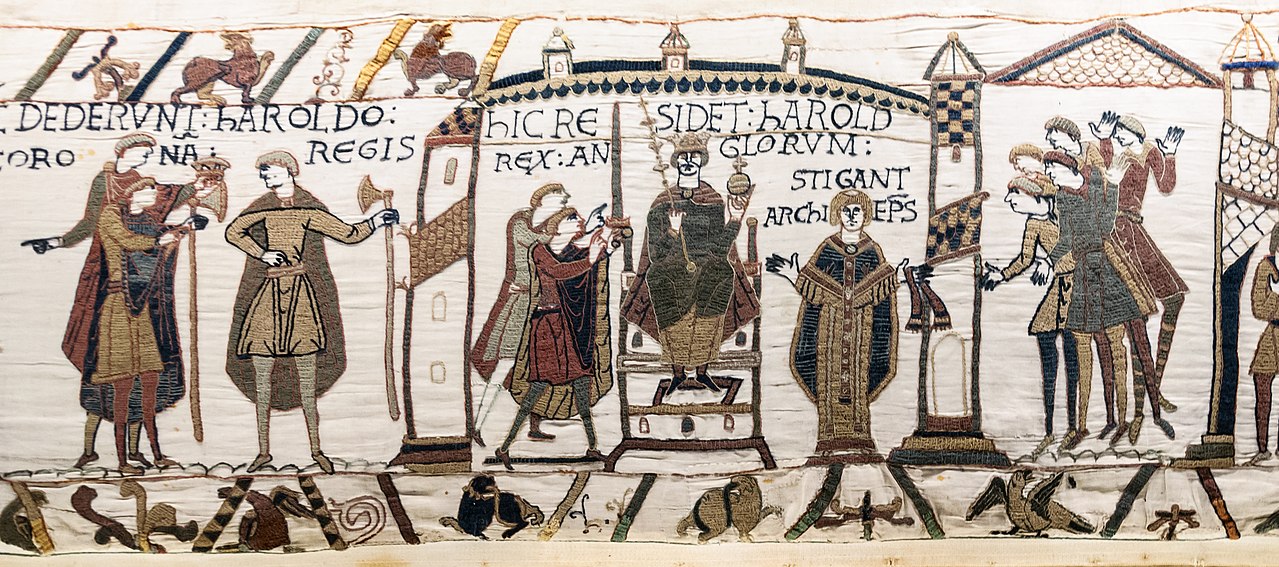
Bayeux Tapestry To Be Displayed In The UK For The First Time

The Bayeux Tapestry is to be displayed in the UK for the first time after an agreement with France.
Theresa May has welcomed plans for the artwork to come to the UK as "very significant".
The Prime Minister said it was important that "the maximum number of people" will be able to see the work depicting the Battle of Hastings.
What is the Bayeux Tapestry?
Although it is called a tapestry, it is, in fact, an embroidery stitched with 10 shades of woollen yarn.
It chronicles events leading up to the Norman conquest of England by William the Conqueror and culminates in the Battle of Hastings and the defeat of Harold in 1066.
It is nearly 70 metres (230ft) long, 50cm (1.6ft) high and made of nine panels of linen cloth.
Nothing is known for certain about its origins, with the first written record appearing in the Bayeux Cathedral's inventory of treasures in 1476.
It is believed to have been stitched in England by nuns of St Augustine's Abbey.
Napoleon put it on display in Paris in 1804 and it was briefly exhibited at the city's Louvre in 1944.
Now it is exhibited in the Bayeux Museum in Normandy.

Where will it be exhibited?
The British Museum would be "honoured and delighted" to display the tapestry if it comes to the UK, its director has said.
Hartwig Fischer explained:
"This would be a major loan, probably the most significant ever from France to the UK.
"It is a gesture of extraordinary generosity and proof of the deep ties that link our countries.
"The Bayeux Tapestry is of huge importance, as it recounts a crucial moment in British and French history, 1066."
But at Prime Minister's Questions, Mrs May received rival bids for a site to host the tapestry.
Bexhill and Battle MP Huw Merriman said Battle Abbey would be an appropriate location, on the site where the 1066 clash took place.
Home Secretary Amber Rudd also suggested her Hastings and Rye constituency should be in contention for the honour.
Mrs May said: "It is very significant that the Bayeux Tapestry is going to be coming to the United Kingdom and that people are going to be able to see this."
Acknowledging the rival claims to host the tapestry she said:
"I am sure we will be looking very carefully to ensure that the maximum number of people can take the benefit of seeing this tapestry."
When will it arrive in the UK?
Mrs May will discuss loaning the tapestry to the UK when she meets French President Emmanuel Macron on Thursday.
However, it could take five years before it reaches British shores, and a spokesman for Mr Macron has said it will definitely not be in the UK before 2020.
This is because the tapestry will need restoration work to ensure it is not damaged in transit, an official in Mr Macron's office told reporters in France.
"This loan is under consideration because there will be several months of restoration work at the Museum of Bayeux..
"It will not be before 2020 because it is an extremely fragile cultural treasure which will be subject to major restoration work before being transported anywhere."

What do the experts say?
Dr Levi Roach, medieval historian at the University of Exeter, said:
"As Britain seeks to renegotiate its relationship with France, there could scarcely be a better symbol of the close yet fraught ties that have bound the two nations together.
"Probably made in England for William the Conqueror's half-brother Odo of Bayeux, the Bayeux Tapestry - or more accurately embroidery - depicts events from a Norman perspective, but with real sympathy for the fate of the English.
"During the French Revolution, it was confiscated for military use, for covering wagons, and was only saved from this fate by a local lawyer."
If it returns to the UK, medieval historians would finally have the chance to study the back of the work.
It is believed that the famous arrow-in-the-eye scene allegedly depicting the death of the English King Harold was added to the Bayeux Tapestry in Victorian times.
Speaking on Good Morning Britain on Wednesday, scholar Maggie Kneen said until now, scholars have only been provided with footage and photographs of the other side of the piece.
Ms Kneen said: "It was made in Canterbury, it's more or less been proven by art historical means - it's such a marvellous piece of news. It's just going to be so important for children to learn from it."
She added: "From what I believe, the actual arrow was a Victorian addition. The actual arrow that was stitched onto the tapestry was added on later on."
"Really to see the back of it rather than a CD of images would be tremendous for scholars."
Cover picture courtesy of PA.









